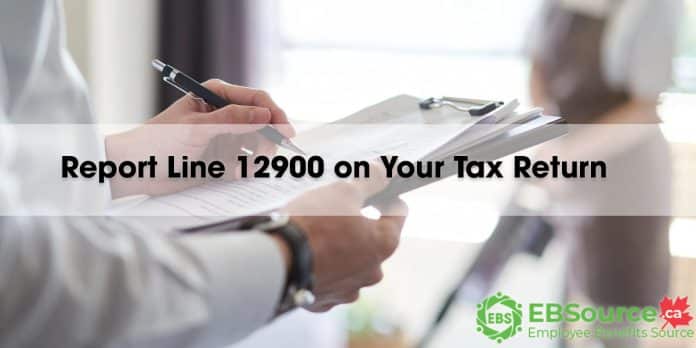Did you withdraw or receive payments from an RRSP last year? If so, you need to make sure you fully report that income on your T1 income tax return. Failing to report RRSP income accurately can lead to tax troubles and problems with CRA down the road. This easy guide will walk you through how to properly report RRSP withdrawals and income on Line 12900.
What is Line 12900?
Line 12900 on your T1 General Income Tax and Benefit Return is where you report all taxable income received from your Registered Retirement Savings Plans (RRSPs).
This line is used to report the total income you withdrew or were paid from your RRSPs during the tax year. Any funds removed from or paid out of an RRSP are considered fully taxable income under Canadian tax law.
The total RRSP income you withdraw will be shown on the T4RSP slips issued by your financial institutions. You simply need to enter the total amounts from your T4RSPs onto Line 12900 when filing your taxes.
What Types of Income to Report on Line 12900

Line 12900 is where you report all income received from withdrawals and payments taken from your RRSP during the tax year. Here are the main sources of RRSP income to enter on Line 12900:
Amounts on T4RSP Slips
All amounts shown on your T4RSP slips must be reported on your tax return. The key boxes to pay attention to are:
| Box | Type of Income Reported |
| 16 | Annuity payments from an RRSP |
| 18 | Income earned on RRSP proceeds transferred to another RRSP |
| 20 | Refund of RRSP premiums |
| 22 | Lump sum RRSP withdrawal amounts |
| 26 | Amounts paid from an RRSP to a spouse or common-law partner due to a relationship breakdown |
| 28 | Income resulting from transfers of excess amounts from one RRSP to another |
| 34 | Supplemental annuity payments, such as annual top-ups to a base amount |
Be sure to verify no amounts were withheld for taxes, as shown in Box 30. If so, you must report this tax withheld separately on Line 43700 of your return.
Spousal or Common-Law Partner RRSP Income
If your spouse or common-law partner contributed to your RRSP anytime in the year of withdrawal or the preceding two years, you may need to report the RRSP income they withdrew on your own return.
Whether or not you need to report their RRSP income depends on who made the original contributions. You will need to complete Form T2205 to calculate how much of your partner’s RRSP income to claim on Line 12900.
Home Buyers’ Plan (HBP) and Lifelong Learning Plan (LLP) Repayments
If you previously withdrew RRSP funds under the HBP to purchase a home or the LLP to finance education, you may need to repay a portion of your RRSP each year.
The HBP and LLP set minimum annual repayment amounts you must contribute to avoid paying tax on it. If you repay less than the minimum repayment amount in a given tax year, the remaining balance must be reported as income on Line 12900.
How to Report RRSP Income on Line 12900
Here are the four steps to accurately report RRSP income on your T1 tax return:
1. Total All Amounts from T4RSP Slips
- Add together amounts from Boxes 16, 18, 20, 22, 26, 28 and 34 from all your T4RSP slips.
- Be sure to also total any tax withheld shown in Box 30.
2. Calculate Any Spousal or Common-Law Partner Income
- If your partner contributed to your RRSP in the past 3 years, use Form T2205 to determine if you must report a portion of their RRSP withdrawal.
- The form helps calculate how much to claim based on who originally contributed the funds.
3. Determine HBP and LLP Repayment Shortfalls
- If you failed to repay the annual minimum amounts under the HBP or LLP, calculate the difference between what you were supposed to repay and what was actually repaid.
- Any repayment shortfalls must be reported as income on Line 12900.
4. Enter Totals on Line 12900 and 43700
- On Line 12900, enter the total of all RRSP income amounts determined in steps 1-3 above.
- On Line 43700, enter the total tax withheld shown in Box 30 of your T4RSP slips.
Following the four steps above ensures you accurately report all taxable RRSP income without omissions or errors. If you are unsure about any amounts, consult the CRA guides or a tax professional.
When You Must Report RRSP Income
In general, you must report RRSP income on your tax return for the year when amounts are:
| Type of Payment or Withdrawal | Tax Treatment |
| Cash withdrawals from an RRSP | Taxable income in the year of withdrawal |
| Funds transferred from RRSP to RRIF | Considered withdrawal, taxable income |
| Annuity or pension payments received | Taxable income in the year received |
| RRSP proceeds transferred from deceased spouse | Taxable income even if transferred to your own RRSP |
| Withdrawals in the first 60 days of the following year | Can be reported in either the current or previous tax year |
Who Has to Report RRSP Income
The responsibility to report RRSP income depends on who holds the plan and who made contributions. Here are the general rules:
RRSP Account Holders
The primary holder of an RRSP must report any amounts withdrawn or paid out of that plan on their own tax return.
Spouses Who Contributed
If you contributed to an RRSP owned by your spouse or common-law partner, you may have to report a portion of the income they withdraw, calculated via Form T2205.
This depends on:
- The amount you contributed compared to their contributions
- This applies to contributions made in the year of withdrawal or the preceding two years.
- Helps account for potential spousal income splitting.
Why You Need to Report RRSP Income Accurately
Here are four key reasons it’s critically important to report all RRSP income correctly on your T1 tax return:
- Any RRSP withdrawals are fully taxable under the Income Tax Act. Not reporting income could lead to reassessments and tax owed.
- Accurate reporting is needed to calculate your tax liability correctly and avoid problems with CRA.
- You need to report income to properly claim RRSP deduction amounts and maximize tax credits.
- Not accurately reporting RRSP income could lead to penalties, interest, and other problems.
The bottom line
Reporting RRSP income doesn’t need to be confusing if you follow the steps in this guide. Just double-check your T4RSP slips, total the amounts, and enter them in Line 12900.
If you have questions, ask a tax preparer for help. Properly reporting your RRSP income will help maximize your tax refund and avoid issues with CRA. You can feel confident knowing your RRSP withdrawals and income are fully accounted for on your tax return.
FAQs related to reporting RRSP income on Line 12900
How do I report RRSP income on my tax return?
You report RRSP income on Line 12900. Add up the amounts from Boxes 16, 18, 20, 22, 26, 28 and 34 on your T4RSP slips. Also enter any tax withheld shown in Box 30 on Line 43700.
What types of payments get reported as RRSP income?
Any amounts withdrawn or paid out of an RRSP must be reported, including lump sum withdrawals, annuity payments, amounts transferred to a RRIF, and payments under the HBP or LLP.
Who has to report income from an RRSP?
The RRSP account holder must report any income they withdraw. Spouses may have to report some of their partner's RRSP income if they made contributions.
How do I calculate RRSP income for split contributions?
If your spouse contributed to your RRSP, use Form T2205 to determine how much RRSP income each of you must report.
Is RRIF income reported on Line 12900?
No, RRIF payments are reported on Line 11500 as pension income. RRSP withdrawals transferred to a RRIF are reported on Line 12900.

